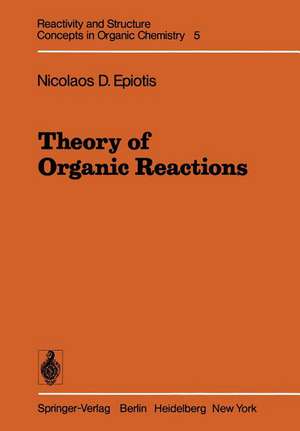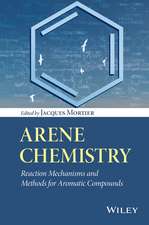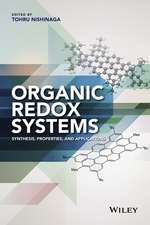Theory of Organic Reactions: Reactivity and Structure: Concepts in Organic Chemistry, cartea 5
Autor N. D. Epiotisen Limba Engleză Paperback – 25 oct 2011
Din seria Reactivity and Structure: Concepts in Organic Chemistry
- 15%
 Preț: 637.93 lei
Preț: 637.93 lei - 15%
 Preț: 638.57 lei
Preț: 638.57 lei -
 Preț: 402.76 lei
Preț: 402.76 lei -
 Preț: 388.13 lei
Preț: 388.13 lei - 15%
 Preț: 650.19 lei
Preț: 650.19 lei -
 Preț: 400.65 lei
Preț: 400.65 lei - 18%
 Preț: 721.63 lei
Preț: 721.63 lei -
 Preț: 378.71 lei
Preț: 378.71 lei -
 Preț: 378.71 lei
Preț: 378.71 lei - 15%
 Preț: 641.53 lei
Preț: 641.53 lei -
 Preț: 380.84 lei
Preț: 380.84 lei - 15%
 Preț: 636.45 lei
Preț: 636.45 lei - 15%
 Preț: 650.37 lei
Preț: 650.37 lei - 15%
 Preț: 640.08 lei
Preț: 640.08 lei -
 Preț: 387.75 lei
Preț: 387.75 lei - 15%
 Preț: 640.06 lei
Preț: 640.06 lei -
 Preț: 387.20 lei
Preț: 387.20 lei -
 Preț: 380.84 lei
Preț: 380.84 lei - 15%
 Preț: 639.08 lei
Preț: 639.08 lei - 15%
 Preț: 639.08 lei
Preț: 639.08 lei -
 Preț: 381.81 lei
Preț: 381.81 lei -
 Preț: 382.57 lei
Preț: 382.57 lei -
 Preț: 395.25 lei
Preț: 395.25 lei - 15%
 Preț: 642.83 lei
Preț: 642.83 lei -
 Preț: 378.54 lei
Preț: 378.54 lei - 15%
 Preț: 636.45 lei
Preț: 636.45 lei - 20%
 Preț: 546.17 lei
Preț: 546.17 lei - 15%
 Preț: 638.43 lei
Preț: 638.43 lei
Preț: 643.34 lei
Preț vechi: 756.86 lei
-15% Nou
Puncte Express: 965
Preț estimativ în valută:
123.16€ • 128.51$ • 103.24£
123.16€ • 128.51$ • 103.24£
Carte tipărită la comandă
Livrare economică 12-26 martie
Preluare comenzi: 021 569.72.76
Specificații
ISBN-13: 9783642668296
ISBN-10: 3642668291
Pagini: 312
Ilustrații: XIV, 290 p.
Dimensiuni: 170 x 244 x 16 mm
Greutate: 0.5 kg
Ediția:Softcover reprint of the original 1st ed. 1978
Editura: Springer Berlin, Heidelberg
Colecția Springer
Seria Reactivity and Structure: Concepts in Organic Chemistry
Locul publicării:Berlin, Heidelberg, Germany
ISBN-10: 3642668291
Pagini: 312
Ilustrații: XIV, 290 p.
Dimensiuni: 170 x 244 x 16 mm
Greutate: 0.5 kg
Ediția:Softcover reprint of the original 1st ed. 1978
Editura: Springer Berlin, Heidelberg
Colecția Springer
Seria Reactivity and Structure: Concepts in Organic Chemistry
Locul publicării:Berlin, Heidelberg, Germany
Public țintă
ResearchCuprins
1. One-Determinental Theory of Chemical Reactivity.- 1.1 General Principles and Computational Schemes.- 1.2 Qualitative One-Determinental Models of Chemical Reactivity.- 1.3 The Static One Electron Molecular Orbital Model.- 1.4 Orbital Energies. The Donor-Acceptor Classification of Molecules and the Concept of Reaction Polarity.- 1.5 One Electron Interaction Matrix Elements and Overlap Integrals.- 1.6 The Woodward-Hoffmann Molecular Orbital Correlation Diagram.- 2. Configuration Interaction Overview of Chemical Reactivity.- 2.1 General Principles.- 2.2 Qualitative Configuration Interaction Models of Chemical Reactivity.- 2.3 The Static Linear Combination of Fragment Configurations Method.- 2.4 The Static Delocalized Configuration Interaction Method.- 2.5 The Dynamic Delocalized Configuration Interaction Method.- 3. The Dynamic Linear Combination of Fragment Configurations Method.- 3.1 Definitions.- 3.2 General Theoretical Considerations.- 3.3 The Interaction of Diabatic Surfaces.- 3.4 Polarity Control of Barrier Heights and Decay Efficiencies.- 3.5 The Effect of Excitation Energy on Photochemical Barrier Height.- 3.6 Diabatic Surface Interrelationships. A Classification of Chemical Reactions.- 4. Even-Even Intermodular Multicentric Reactions.- 4.1 Potential Energy Surfaces for 2?+2? Cycloadditions.- 4.2 The Effect of Polarity. Potential Energy Surfaces for Nonionic and Ionic In 2?+2? Cycloadditions.- 4.3 Pericyclic, Effectively Pericyclic and Quasipericyclic Reactions.- 4.4 The Effect of Unsymmetrical Substitution and the Effect of Conjugative Substitution.- 4.5 The Regiochemistry of 2?+2? Cycloadditions.- 4.6 Isomeric Reactions and the Topochemistry of 2?+2? Cycloreversions.- 4.7 The Topochemistry of Intramolecular Cycloadditions.- 4.8 The Selectivity-PolarityRelationship.- 4.9 Reaction Intermediates and Types of Organic Mechanisms.- 4.10 2?+2? Nonionic Photocycloadditions Involving n?* Excitation.- 4.11 The Effect of Low Lying Diexcited Diabatic Surfaces in Photoreactions.- 4.12 The Problem of Energy Wastage. The Concept of Dual Channel Photoreactions.- 4.13 Generalizations.- 5. The Problem of Correlation Imposed Barriers.- 6. Reactivity Trends of Thermal Cycloadditions.- 6.1 Introduction.- 6.2 Mechanisms of Stereochemical Nonretention in Cycloadditions.- 6.3 Reactivity Trends of Thermal Nonionic 2?+2? Cycloadditions.- 6.4 Reactivity Trends of Thermal Ionic 2?+2? Cycloadditions.- 6.5 The 2?+2? Ionic Cycloaddition Problem.- 6.6 Reactivity Trends of Thermal Nonionic 4?+2? Cycloadditions.- 6.7 Reactivity Trends of Thermal Ionic 4?+2? Cycloadditions.- 7. Reactivity Trends of Singlet Photochemical Cycloadditions.- 7.1 Introduction.- 7.2 The Chorochemistry of Singlet 2?+2? Photocycloadditions.- 7.3 “Unusual” Head to Head vs. Head to Tail Regioselectivity of Photocycloadditions.- 7.4 n?* State Dual Channel Mechanisms of Polar Nonionic Carbonyl Photocycloadditions.- 7.5 ??* State Dual Channel Mechanisms of Polar Nonionic Photocycloadditions.- 8. Miscellaneous Intermolecular Multicentric Reactions.- 8.1 Cycloadditions of Cumulene Systems.- 8.2 The Ene Reaction.- 8.3 1,3 Dipolar Cycloadditions.- 9. ?? A ddition Reactions.- 9.1 Introduction.- 9.2 Potential Energy Surfaces for 2?+2? Additions.- 9.3 Reactivity Trends of 2?+2? Additions.- 10. Even-Odd Multicentric Intermolecular Reactions.- 10.1 Potential Energy Surfaces for 2?+1? Cycloadditions.- 10.2 Reactivity Trends of Cationic Even-Odd Retro-Cycloadditions and Eliminations.- 11. Potential Energy Surfaces for Odd-Odd Multicentric IntermolecularReactions.- 12. Even-Even Intermolecular Bicentric Reactions.- 12.1 Potential Energy Surfaces for Electrophilic and Nucleophilic Additions.- 12.2 Reactivity Trends of Electrophilic and Nucleophilic Substitutions.- 13. Even-Odd Intermolecular Bicentric Reactions.- 13.1 Potential Energy Surfaces for Radical Additions.- 13.2 Reactivity Trends of Radical Substitution Reactions.- 14. Odd-Odd Intermolecular Bicentric Reactions. Potential Energy Surfaces for Geometric Isomerization and Radical Combination.- 15. Odd-Odd Intramolecular Multicentric Reactions.- 15.1 Potential Energy Surfaces for Sigmatropic Shifts.- 15.2 Reactivity Trends of Sigmatropic Shifts.- 16. Even-Even Intramolecular Multicentric Reactions.- 16.1 Potential Energy Surfaces for Ionic Rearrangements.- 16.2 Reactivity Trends of Ionic Rearrangements.- 17. Mechanisms of Electrocyclic Reactions.- 17.1 Introduction.- 17.2 Reactivity Trends of Electrocyclic Reactions.- 18. Triplet Reactivity.- 18.1 Introduction.- 18.2 Excited State Spin Multiplicity and Photochemical Barrier Heights.- 18.3 The Mechanism of Spin Inversion in Triplet Nonionic Photoaromatic Reactions.- 18.4 The Mechanism of Spin Inversion in Triplet Nonionic Photoantiaromatic Reactions.- 18.5 Spin-Orbit Coupling Borrowing.- 18.6 Mechanisms of Triplet Photoreactions.- 18.7 A Model of Triplet Reactivity.- 18.8 Spin-Orbit Coupling and the Chorochemistry of Triplet Photocycloadditions.- 18.9 Spin-Orbit Coupling and the Regiochemistry of Triplet Photoaromatic Substitutions.- 19. Photophysical Processes.- 20. The Importance of Low Lying Nonvalence Orbitals.- 21. Divertissements.- 21.1 Thermal Antiaromatic Pericyclic Reactions.- 21.2 Induced Thermal Pericyclic Reactions.- 21.3 Half-Aromatic Reaction Paths.- 21.4 Ambident Reactivity.- 21.5 The Stereoselectivity of Photocycloadditions: In Search of Antiaromatic Intermediates.- 22. A Contrast of “Accepted” Concepts of Organic Reactivity and the Present Work.- Epilogue.- References.- Author Index.






